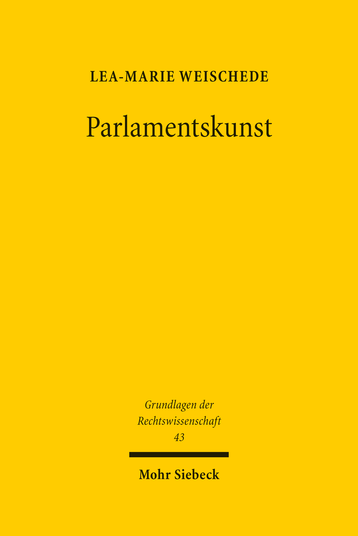Law
Lea-Marie Weischede
Parlamentskunst
Zur Staatsästhetik freiheitlicher Demokratie
[Parliamentary Art. On the State Aesthetics of Liberal Democracy.]
99,00 €
including VAT
including VAT
cloth
ISBN 978-3-16-161363-0
available
Also Available As:
Published in German.
Connecting aesthetics and politics to public perceivable visualisations of political power is often met with scepticism when applied to liberal democracy: It is argued that staging political power overdrew the autonomous deliberation of the political will and undermined the democratic process. The work confronted this criticism of aesthetisations in democracy, and, using visual arts in the German Bundestag as an example, unfolded the significance and contours of democratic state aesthetics from the perspective of German constitutional law.In a democratic order, state aesthetics, describing the entirety of sensually perceptible self-expressions of the state, evolve within legally formalised procedures. Therefore, state aesthetics of democracy performatively enact content and validity of the legal order within which political power is exercised. Hence, staging political power does not overdraw democratic procedures but creates a space in which the political autonomy of the people, which is only realised through a legally guided process, can be experienced. Democracy’s state aesthetics are a self-descriptive reflection of the political community and can contribute to the democratic society’s political integration.
In the federalist state of the Basic Law, the competency to define the Federal Republic’s state aesthetics lies originally with the German Bundestag. While the Basic Law lays down single elements of the state aesthetics, it refrains from abstract-general specifications with regard to their content-conceptual shapes. However, state aesthetics must adhere to the constitution’s contents and are subject to a principle of neutrality that condenses the differentiations of political-state and social contexts laid down in the Basic Law, i.e., through fundamental rights of individuals and equal opportunities for political parties.
State aesthetics can manifest in works of visual art by means of a dedication act by the state. This dedication act usually appears in the form of purchases and commissions for state buildings, providing the works with a statement about the state. Visual arts in Parliamentary buildings are of particular importance in democracy’s iconography by virtue of the functionally charged significance of its spatial context. This cooperation of art and politics within democratic state aesthetics confronts two claims of validity: artistic autonomy on the one hand and political sovereignty on the other.
In the selection of artists and art works for the state domain, the artistic freedom (Art. 5(3) of the Basic Law) in tandem with the principle of equality (Art. 3(1) of the Basic Law) requires artistic differentiations by the state to be based on objective reasons related to the motives of a democratic order to give itself an artistic-aesthetic expression: In democracy, state art aesthetics take up the political-social functions of liberal art. State art aesthetics can create objects for political identification as well as sensitively point out political-social tendencies and contribute to their negotiation. Within such a teleologically predefined framework, the state’s art selection may consider the aesthetic quality regarding the art works’ characteristics besides personal or biographical spects of the artists. Visual arts as part of the state aesthetics must uphold other constitutional values and be consistent with the content of the political order laid down in the Basic Law. In the state art aesthetics of a liberal order, there must be no monopolies of interpretation, neither for the participating artists nor for the state.
Within art commissions, the tension between the political sovereignty and the autonomy of the artists, like the state's selection of art, is normatively balanced by the social-political functions of liberal arts within the state’s sphere. Overdetermination by the state commissioner would contradict the Basic Law’s liberal concept of arts. However, works that were entirely left to the artists’ autonomy would hardly be a self-portrayal of the political community. Unlike in the genuinely social sphere, state actors can formulate certain guidelines for art works and are also free to decide for a commissioned work not to be included in the state aesthetics. Voluntary adaptations by artists do not violate their artistic freedom.
Procedures and organisation regarding state art aesthetics must enable appropriate decisions to be made regarding the realisation of the motives shown for state art aesthetics in democracy. Art expert votes contribute to more competent differentiations in terms of artistic quality. The principle of democracy, however, reserves the final decision for the state actors. Artistic evaluations by the state, which do not determine what art is, but only how art is, if it serves the state aesthetics, do not contradict the artistic freedom. This also applies to debates and votes on art works in Parliament. Eventually, the art selection must in principle follow competitive and co-operative procedures with the possibility of early mutual agreements between all actors.
The shown principles for the state selection of visual arts provide the normative framework in which art aesthetics unfold as a part of democracy’s state aesthetics, generating self-descriptions of the political community to reflect by its members in the democratic discourse.
